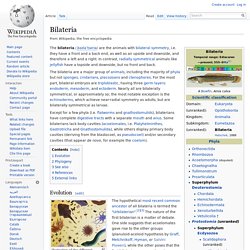

Animal. Most known animal phyla appeared in the fossil record as marine species during the Cambrian explosion, about 542 million years ago.

Eumetazoa. Eumetazoa (Greek: εὖ [eu], well + μετά [metá], after + ζῷον [zóon], animal) is a clade comprising all major animal groups except sponges, placozoa, and several other obscure or extinct life forms, such as Dickinsonia.

Characteristics of eumetazoans include true tissues organized into germ layers, and an embryo that goes through a gastrula stage. The clade is usually held to contain at least Ctenophora, Cnidaria, and Bilateria. Whether mesozoans and placozoans belong is in dispute. Ctenophora now appear basal metazoa.[1] Some phylogenists have speculated the sponges and eumetazoans evolved separately from single-celled organisms, which would mean that the animal kingdom does not form a clade (a complete grouping of organisms descended from a common ancestor). Eumetazoans are a major group of animals in the Five Kingdoms classification of Lynn Margulis and K.
Taxonomy[edit] However, many skeptics emphasize the pitfalls and inconsistencies associated with the new data. Bilateria. Except for a few phyla (i.e. flatworms and gnathostomulids), bilaterians have complete digestive tracts with a separate mouth and anus.

Some bilaterians lack body cavities (acoelomates, i.e. Platyhelminthes, Gastrotricha and Gnathostomulida), while others display primary body cavities (deriving from the blastocoel, as pseudocoel) and/or secondary cavities (that appear de novo, for example the coelom). Evolution[edit] Illustration of the different types of symmetry in lifeforms (Field Museum, Chicago). Bilateral forms can have heads. Phylogeny[edit] A modern (2011) consensus phylogeny for bilateria is shown below, although the position of certain clades are still controversial and the tree has changed considerably between 2000 and 2010.[15] Nodes marked with * have received broad consensus. See also[edit] Embryological origins of the mouth and anus References[edit] Jump up ^ Martin, M.
External links[edit] Protostome. More recent research, however, shows that in protostomes the edges of the dent close up in the middle, leaving openings at the ends which become the mouth and anus.[1][clarification needed] However, this idea has been challenged, because the Acoelomorpha, a group which may be the sister group to the rest of the bilaterian animals, have a single mouth which leads into a blind gut (with no anus).

The genes employed in the embryonic construction of this mouth are the same as those expressed around the protostome mouth.[2] There are other significant differences between the protostome and deuterostome patterns of development: Most protostomes are schizocoelomates, meaning a solid mass of the embryonic mesoderm splits to form a coelom. A few, such as Priapulids, have no coelom, but they may have descended from schizocoelomate ancestors. Current molecular data suggest that protostome animals can be divided into three major groups: Ecdysozoa. The group was initially contested by a significant minority of biologists.

Some argued for groupings based on more traditional taxonomic techniques,[4] while others contested the interpretation of the molecular data.[5][6] Group characters[edit] A tardigrade (water bear) and a nematode (roundworm) The most notable characteristic shared by ecdysozoans is a three-layered cuticle (four in Tardigrada[7]) composed of organic material, which is periodically molted as the animal grows.
This process of molting is called ecdysis and gives the group its name. Deuterostome. Deuterostomes (taxonomic term: Deuterostomia; from the Greek: "mouth second") are any members of a superphylum of animals.

Deuterostomia is a subtaxon of the Bilateria branch of the subkingdom Eumetazoa, within Animalia, and are opposed to the protostomes. Deuterostomes are distinguished from protostomes by their embryonic development; in deuterostomes, the first opening (the blastopore) becomes the anus, while in protostomes it becomes the mouth. Deuterostomes are also known as enterocoelomates because their coelom develops through enterocoely. There are four extant phyla of deuterostomes: Superphylum Deuterostomia was redefined in 1995 based on molecular sequence analyses when the lophophorates were removed from it and combined with other protostome animals to form superphylum Lophotrochozoa.[2] The phylum Chaetognatha (arrow worms) may also belong here.
In both deuterostomes and protostomes, a zygote first develops into a hollow ball of cells, called a blastula.